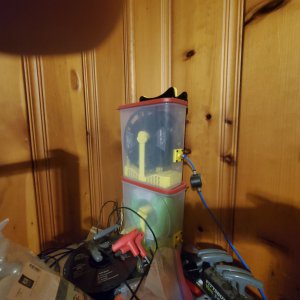- Joined
- Dec 18, 2019
- Messages
- 6,447
Thanks for the report. I feel a little better. My original design in PLA was 3.6mm walls with a 2.8 mm pocket. It printed ok. Then I wanted to test changing the wall and pocket thickness. I was hoping to use PETG for the final box. A prototype design was made and printed in petg flat with the original thickness and pocket depth. It looked very good. I then redesigned it to 3.0mm thick and a 2.6mm pocket. It also printed ok flat.So, I ran your part on my MK3S+ and got almost the same result as you did so my guess is it's something to do with your model or .stl file. The part I labelled #1 is your .stl file sliced by my PrusaSlicer 2.5.0 using my settings which are mostly unchanged since I don't usually have trouble printing PETG. Supports everywhere. The one labelled #2 is your g-code run directly on my printer. There are the circular "echoes" on both parts. See the last photo.
I suggest making the wall a little thicker or make deeper pockets for the magnets with a bumpout on the back if that will work for you.
#1 below
View attachment 427498
#2 below
View attachment 427499
Front of Both (below)
View attachment 427500
Back of Both (below)
View attachment 427501
But in the vertical orientation, the 3mm thick unit never printed ok in petg. The filament I got, doesn't seem to be a good specimen. I think it is soggy and it needs lower temperatures to work. My vertical finish quality improved a lot using lower temperatures. However, having only 0.4mm wall thickness at the bottom of the pocket isn't working in PETG. My PLA design had 0.8mm thick walls down in the pocket and came out ok.
Tomorrow, I may try PETG on the original design, but vertical, with 3.6mm walls and 2.8mm pockets. But first I have to clean off the crap off my plate. I don't know how to remove the residual filament. I fear this filament used at 250C and 90C base temp has over adhered to the satin sheet. Hopefully tomorrow may bring some more clarity.


